SPST-0178 Market Risk Capital Requirements - 2019
SPST-0178 Market Risk Capital Requirements - 2019.doc
Market Risk Capital Requirements
OMB: 3064-0178
SUPPORTING STATEMENT
Market Risk Capital Requirements
(OMB Control No. 3064-0178)
INTRODUCTION
The Federal Deposit Insurance Corporation (FDIC) is requesting a three-year renewal of the information collection for its collection (3064-0178) associated with market risk capital requirements. The current clearance for the collection expires on May 31, 2019. There is no change in the method or substance of the collection. However, the FDIC has reassessed its number of respondents as well as the frequency of responses per respondent per year.
JUSTIFICATION
Circumstances that make the collection necessary:
The FDIC’s market risk capital rules (12 CFR part 324, subpart F) enhance risk sensitivity, increase transparency through enhanced disclosures and include requirements for the public disclosure of certain qualitative and quantitative information about the market risk of state nonmember banks and state savings associations (FDIC-supervised institutions). The market risk rule applies only if a bank holding company or bank has aggregated trading assets and trading liabilities equal to 10 percent or more of quarter-end total assets or $1 billion or more (covered FDIC-supervised institutions). Currently, only one FDIC-regulated entity meets the criteria of the information collection requirements that are located at 12 CFR 324.203 through 324.212. The collection of information is necessary to ensure capital adequacy appropriate for the level of market risk.
Section 324.203(a)(1) requires covered FDIC-supervised institutions to have clearly defined policies and procedures for determining which trading assets and trading liabilities are trading positions and specifies the factors a covered FDIC-supervised institution must take into account in drafting those policies and procedures. Section 324.203(a)(2) requires covered FDIC-supervised institutions to have clearly defined trading and hedging strategies for trading positions that are approved by senior management and specifies what the strategies must articulate. Section 324.203(b)(1) requires covered FDIC-supervised institutions to have clearly defined policies and procedures for actively managing all covered positions and specifies the minimum requirements for those policies and procedures. Sections 324.203(c)(4) through 324.203(c)(10) require the annual review of internal models and specify certain requirements for those models. Section 324.203(d) requires the internal audit group of a covered FDIC-supervised institution to prepare an annual report to the board of directors on the effectiveness of controls supporting the market risk measurement systems.
Section 324.204(b) requires covered FDIC-supervised institutions to conduct quarterly backtesting. Section 324.205(a)(5) requires institutions to demonstrate to the FDIC the appropriateness of proxies used to capture risks within value-at-risk models. Section 324.205(c) requires institutions to develop, retain, and make available to the FDIC value-at-risk and profit and loss information on sub-portfolios for two years. Section 324.206(b)(3) requires covered FDIC-supervised institutions to have policies and procedures that describe how they determine the period of significant financial stress used to calculate the institution’s stressed value-at-risk models and to obtain prior FDIC approval for any material changes to these policies and procedures.
Section 324.207(b)(1) details requirements applicable to a covered FDIC-supervised institution when the covered FDIC-supervised institution uses internal models to measure the specific risk of certain covered positions. Section 324.208 requires covered FDIC-supervised institutions to obtain prior written FDIC approval for including equity positions in its incremental risk modeling. Section 324.209(a) requires prior FDIC approval for the use of a comprehensive risk measure. Section 324.209(c)(2) requires covered FDIC-supervised institutions to retain and report the results of supervisory stress testing. Section 324.210(f)(2)(i) requires covered FDIC-supervised institutions to document an internal analysis of the risk characteristics of each securitization position in order to demonstrate an understanding of the position. Section 324.212 applies to certain covered FDIC-supervised institutions that are not subsidiaries of bank holding companies, and requires quarterly quantitative disclosures, annual qualitative disclosures, and a formal disclosure policy approved by the board of directors that addresses the approach for determining the market risk disclosures it makes.
Use of the information:
The FDIC will use the data in this proposed collection to assess the adequacy of a covered institution’s capital held to cover exposure to market risk associated with foreign exchange and commodity positions and positions located in the trading account.
Consideration of the use of improved information technology:
Respondents may use any available technology to reduce burden.
Effort to identify duplication:
The collections of information are unique and cover the institution’s particular circumstances. No duplication exists.
Methods used to minimize burden if the collection has a significant impact on a substantial number of small entities:
This collection does not have a significant impact on a substantial number of small entities. In particular, according to Call Report data as of September 30, 2018, there were 3,533 FDIC-supervised institutions. Of these entities, 2,726 have total assets of less than $550 million therefore meeting the Small Business Administration’s definition of a “small entity.” However, there are neither FDIC-supervised institutions with aggregate trading assets and trading liabilities equal to 10 percent or more of quarter-end total assets, nor FDIC-supervised institutions with aggregate trading assets and trading liabilities equal to $1 billion or more. For purposes of this information collection, a placeholder of one is used for the estimated number of respondents. Therefore, the impact of these small entities is not significant.
Consequences to the Federal program if the collection were conducted less frequently:
Without this information, the FDIC would be unable to meet the requirements of the statute.
Special circumstances necessitating collection inconsistent with 5 CFR 1320.5(d)(2):
None. This information collection is conducted in accordance with the guidelines in 5 CFR 1320.5(d)(2).
Efforts to consult with persons outside the agency:
A 60-day Federal Register notice seeking public comment was published on February 1, 2019 (84 FR 1121). No comments were received.
Payment or gift to respondents:
None.
Any assurance of confidentiality:
Information collected is kept private to the extent allowed by law. All required records are subject to the confidentiality requirements of the Privacy Act. In addition, any information deemed to be of a confidential nature is exempt from public disclosure in accordance with the provisions of the Freedom of Information Act (5 U.S.C. 552).
Justification for questions of a sensitive nature:
No questions of a sensitive nature are included in the collection.
Estimate of Hour Burden Including Annualized Hourly Costs:
Summary of Annual Burden (3064-0178) |
|||||||
Information Collection (IC) Description |
Type of Burden |
Obligation to Respond |
Estimated Number of Respondents |
Estimated Frequency of Responses |
Estimated Time per Response |
Frequency of Response |
Total Annual Estimated Burden |
Identification of trading positions |
Recordkeeping |
Mandatory |
1 |
1 |
40 |
On Occasion |
40 |
Trading and hedging strategies |
Recordkeeping |
Mandatory |
1 |
1 |
16 |
On Occasion |
16 |
Active management of covered positions |
Recordkeeping |
Mandatory |
1 |
1 |
16 |
On Occasion |
16 |
Review of internal models |
Recordkeeping |
Mandatory |
1 |
1 |
16 |
On Occasion |
16 |
Internal audit report |
Reporting |
Mandatory |
1 |
1 |
16 |
On Occasion |
16 |
Backtesting adjustments to risk-based capital ratio calculations |
Recordkeeping |
Mandatory |
1 |
4 |
16 |
On Occasion |
64 |
Demonstrate appropriateness of proxies |
Recordkeeping |
Mandatory |
1 |
1 |
8 |
On Occasion |
8 |
Retention of subportfolio information |
Recordkeeping |
Mandatory |
1 |
1 |
24 |
On Occasion |
24 |
Stressed Var-based measure quantitative requirements |
Reporting |
Mandatory |
1 |
4 |
40 |
On Occasion |
160 |
Modeled specific risk |
Reporting |
Mandatory |
1 |
4 |
88 |
On Occasion |
352 |
Incremental risk model-prior approval |
Reporting |
Mandatory |
1 |
4 |
480 |
On Occasion |
1,920 |
Comprehensive risk measurement-prior approval |
Reporting |
Mandatory |
1 |
4 |
480 |
On Occasion |
1,920 |
Requirements of stress testing |
Recordkeeping |
Mandatory |
1 |
1 |
80 |
On Occasion |
80 |
Securitization positions |
Recordkeeping |
Mandatory |
1 |
4 |
120 |
On Occasion |
480 |
Quantitative market risk disclosures |
Third-Party Disclosure |
Mandatory |
1 |
4 |
8 |
On Occasion |
32 |
Disclosure policy |
Recordkeeping |
Mandatory |
1 |
1 |
40 |
On Occasion |
40 |
Quantitative disclosures for each portfolio of covered positons |
Third-Party Disclosure |
Mandatory |
1 |
4 |
8 |
On Occasion |
32 |
Qualitative disclosures for each portfolio of covered positons |
Third-Party Disclosure |
Mandatory |
1 |
1 |
12 |
On Occasion |
12 |
TOTAL HOURLY BURDEN |
5,228 |
||||||
The estimated labor cost1 is $351,589 and is based on the following:
ICs #1 and #16:
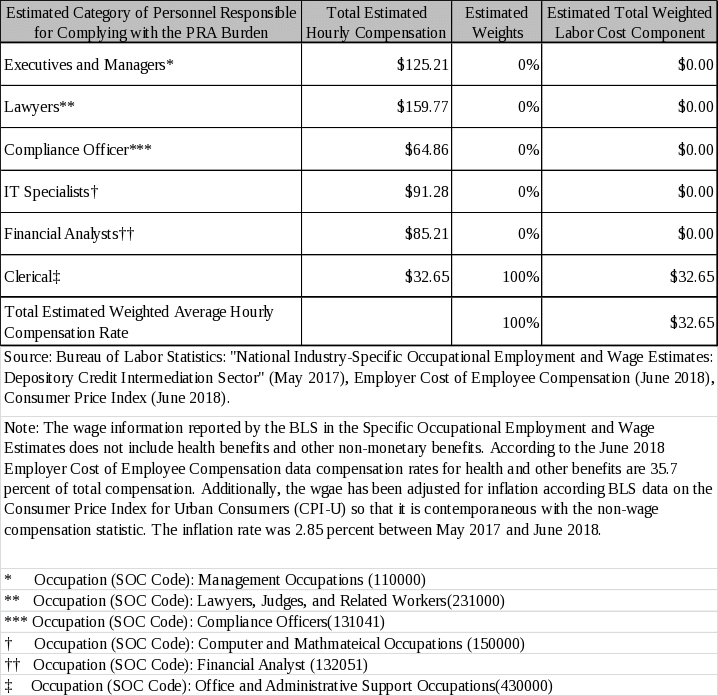
Using the estimated hour burden and the wage estimate for IC #1, the estimated cost burden of IC #1 is $1,306: 40 hours * $32.65 per hour.
Using the estimated hour burden and the wage estimate for IC #16, the estimated cost burden of IC #16 is $1,306: 40 hours * $32.65 per hour.
ICs #2, 3, 4, and 5:
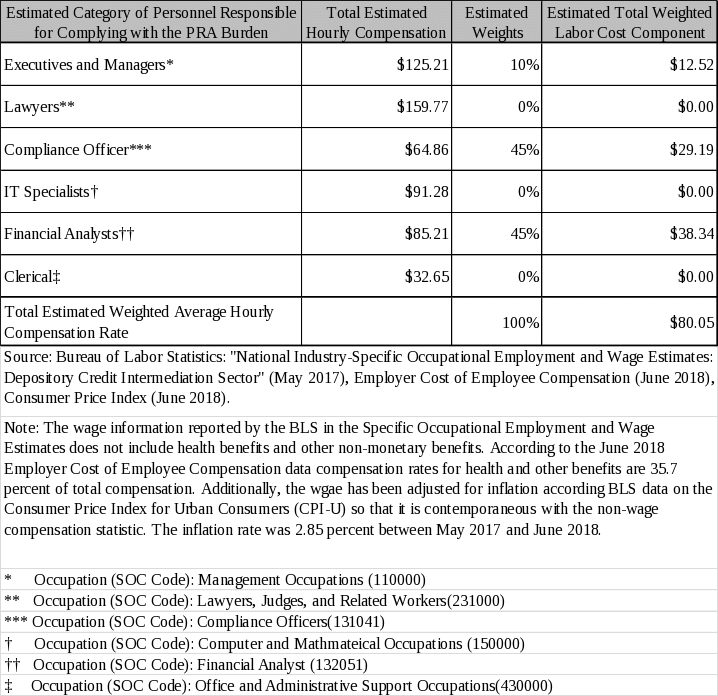
Using the estimated hour burden and the wage estimate for IC #2, the estimated cost burden of IC #2 is $1,280.80: 16 hours * $80.05 per hour.
Using the estimated hour burden and the wage estimate for IC #3, the estimated cost burden of IC #3 is $1,280.80: 16 hours * $80.05 per hour.
Using the estimated hour burden and the wage estimate for IC #4, the estimated cost burden of IC #4 is $1,280.80: 16 hours * $80.05 per hour.
Using the estimated hour burden and the wage estimate for IC #5, the estimated cost burden of IC #5 is $1,280.80: 16 hours * $80.05 per hour.
ICs #6, 8, 17, and 18:
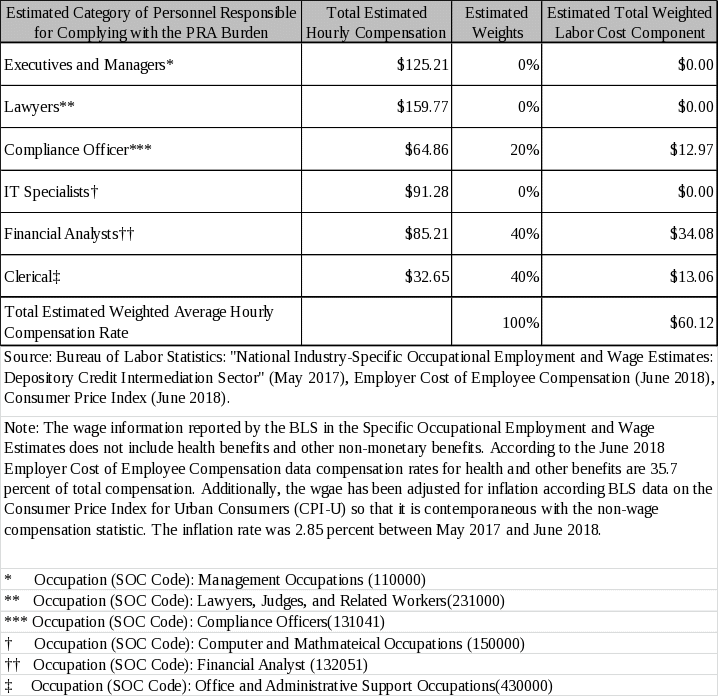
Using the estimated hour burden and the wage estimate for IC #6, the estimated cost burden of IC #6 is $3,847.04: 64 hours * $60.11 per hour.
Using the estimated hour burden and the wage estimate for IC #8, the estimated cost burden of IC #8 is $1,442.64: 24 hours * $60.11 per hour.
Using the estimated hour burden and the wage estimate for IC #17, the estimated cost burden of IC #17 is $1,923.52: 32 hours * $60.11 per hour.
Using the estimated hour burden and the wage estimate for IC #18, the estimated cost burden of IC #18 is $721.32: 12 hours * $60.11 per hour.
ICs #7, 9, 10, 11, 12, 13, and 14:
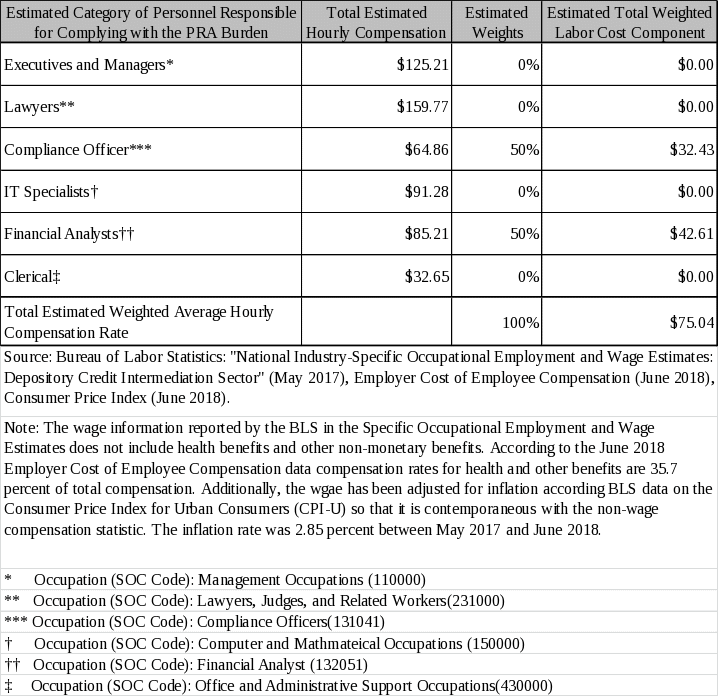
Using the estimated hour burden and the wage estimate for IC #7, the estimated cost burden of IC #7 is $600.24: 8 hours * $75.03 per hour.
Using the estimated hour burden and the wage estimate for IC #9, the estimated cost burden of IC #9 is $12,004.80: 160 hours * $75.03 per hour.
Using the estimated hour burden and the wage estimate for IC #10, the estimated cost burden of IC #10 is $26,410.56: 352 hours * $75.03 per hour.
Using the estimated hour burden and the wage estimate for IC #11, the estimated cost burden of IC #11 is $144,057.60: 1,920 hours * $75.03 per hour.
Using the estimated hour burden and the wage estimate for IC #12, the estimated cost burden of IC #12 is $144,057.60: 1,920 hours * $75.03 per hour.
Using the estimated hour burden and the wage estimate for IC #13, the estimated cost burden of IC #13 is $6,002.40: 80 hours * $75.03 per hour.
Using the estimated hour burden and the wage estimate for IC #14, the estimated cost burden of IC #14 is $900.36: 12 hours * $75.03 per hour.
IC #15:
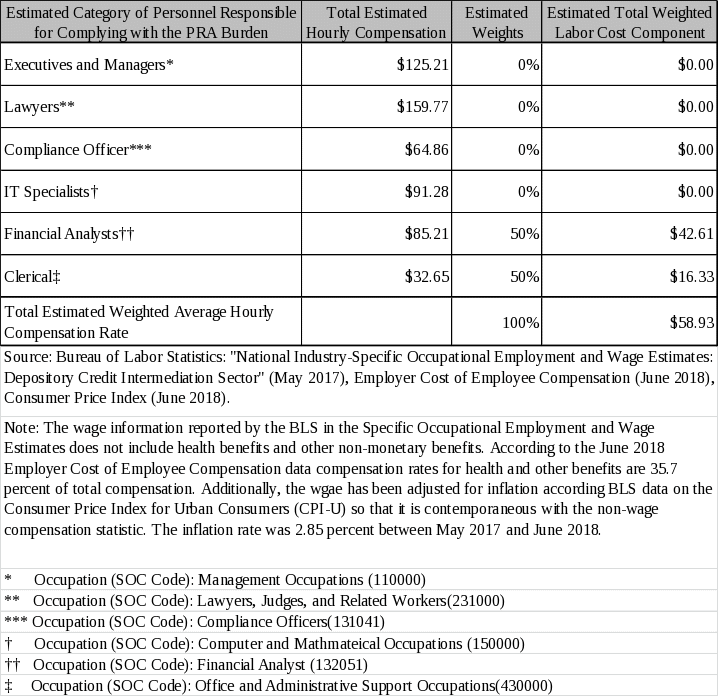
Using the estimated hour burden and the wage estimate for IC #15, the estimated cost burden of IC #15 is $1,885.76: 32 hours * $58.93 per hour.
Total Estimated Cost Burden:
Using the estimated cost burden from all of the component information collections, the total estimated burden for the entire ICR (OMB No. 3064-0178) is $351,589 per year:
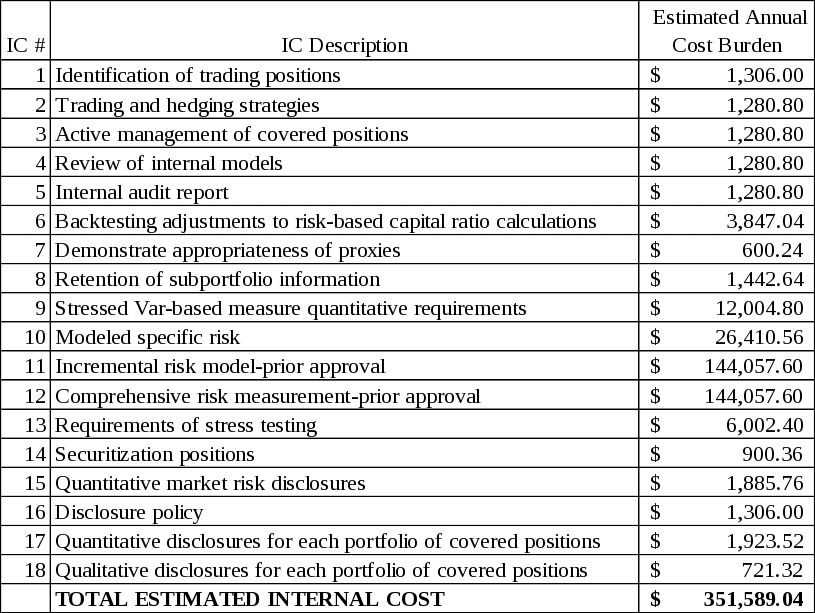
Estimate of Start-up Costs to Respondents:
None.
Estimate of annualized costs to the government:
None.
Analysis of change in burden:
There is no change in the method or substance of the collection. The annual burden for this information collection is estimated to be 5,228 hours. This represents an increase of 1,300 hours from the current burden estimate of 3,928 hours. This increase is not due to any new requirements imposed by the FDIC. Rather, it is due to FDIC’s reassessment of the number of respondents as well as the frequency of responses per respondent per year.
Information regarding collections whose results are planned to be published for
statistical use:
The results of this collection will not be published for statistical use.
Display of Expiration Date
This information collection is contained in a regulation.
Exceptions to Certification Statement
None.
STATISTICAL METHODS
Statistical methods are not employed in these collections.
1 The wage information reported by the Bureau of Labor Statistics (BLS) in the Specific Occupational Employment and Wage Estimates does not include health benefits and other non-monetary benefits. According to the June 2018 Employer Cost of Employee Compensation data compensation rates for health and other benefits are 35.7 percent of total compensation. Additionally, the wage has been adjusted for inflation according BLS data on the Consumer Price Index for Urban Consumers (CPI-U) so that it is contemporaneous with the non-wage compensation statistic. The inflation rate was 2.85 percent between May 2017 and June 2018.
| File Type | application/msword |
| File Modified | 0000-00-00 |
| File Created | 0000-00-00 |
© 2025 OMB.report | Privacy Policy